heating BMW 5 SERIES 2011 Owners Manual
[x] Cancel search | Manufacturer: BMW, Model Year: 2011, Model line: 5 SERIES, Model: BMW 5 SERIES 2011Pages: 304, PDF Size: 10.54 MB
Page 13 of 304
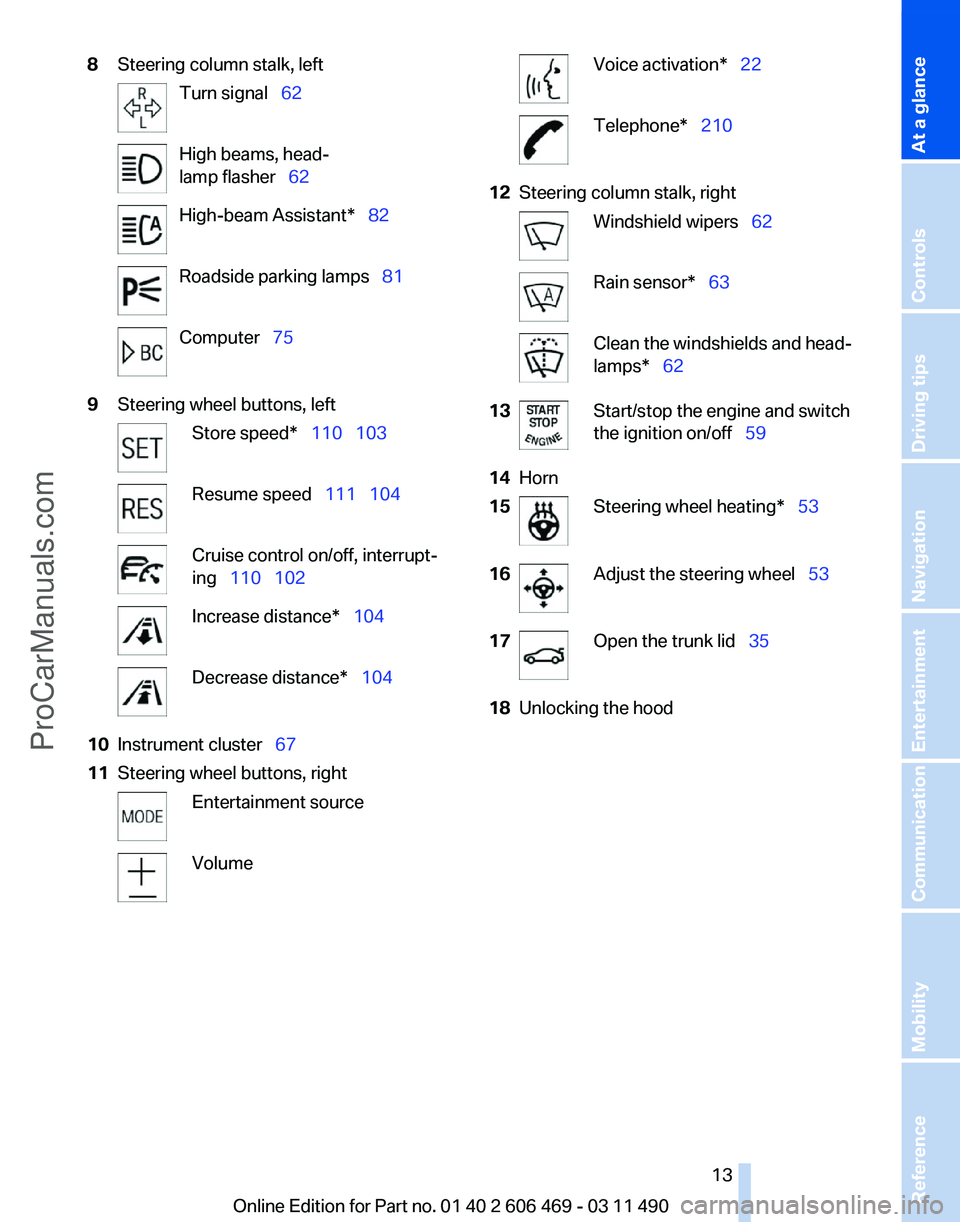
8
Steering column stalk, left Turn signal‚ÄÇ‚ÄÖ62
High beams, head‚Äê
lamp flasher‚ÄÇ‚ÄÖ62
High-beam Assistant*‚ÄÇ‚ÄÖ82
Roadside parking lamps‚ÄÇ‚ÄÖ81
Computer‚ÄÇ‚ÄÖ75
9 Steering wheel buttons, left Store speed*‚ÄÇ‚ÄÖ110‚ÄÇ‚ÄÖ103
Resume speed‚ÄÇ‚ÄÖ111‚ÄÇ‚ÄÖ104
Cruise control on/off, interrupt‚Äê
ing‚ÄÇ‚ÄÖ110‚ÄÇ‚ÄÖ102
Increase distance*‚ÄÇ‚ÄÖ104
Decrease distance*‚ÄÇ‚ÄÖ104
10 Instrument cluster‚ÄÇ‚ÄÖ 67
11 Steering wheel buttons, right Entertainment source
Volume Voice activation*‚ÄÇ‚ÄÖ22
Telephone*‚ÄÇ‚ÄÖ210
12 Steering column stalk, right Windshield wipers‚ÄÇ‚ÄÖ62
Rain sensor*‚ÄÇ‚ÄÖ
63 Clean the windshields and head‚Äê
lamps*‚ÄÇ‚ÄÖ62
13 Start/stop the engine and switch
the ignition on/off‚ÄÇ‚ÄÖ59
14 Horn
15 Steering wheel heating*‚ÄÇ‚ÄÖ53
16 Adjust the steering wheel‚ÄÇ‚ÄÖ
53
17 Open the trunk lid‚ÄÇ‚ÄÖ
35
18 Unlocking the hood
Seite 13
13Online Edition for Part no. 01 40 2 606 469 - 03 11 490
Reference Mobility Communication Entertainment Navigation Driving tips Controls
At a glance
ProCarManuals.com
Page 47 of 304
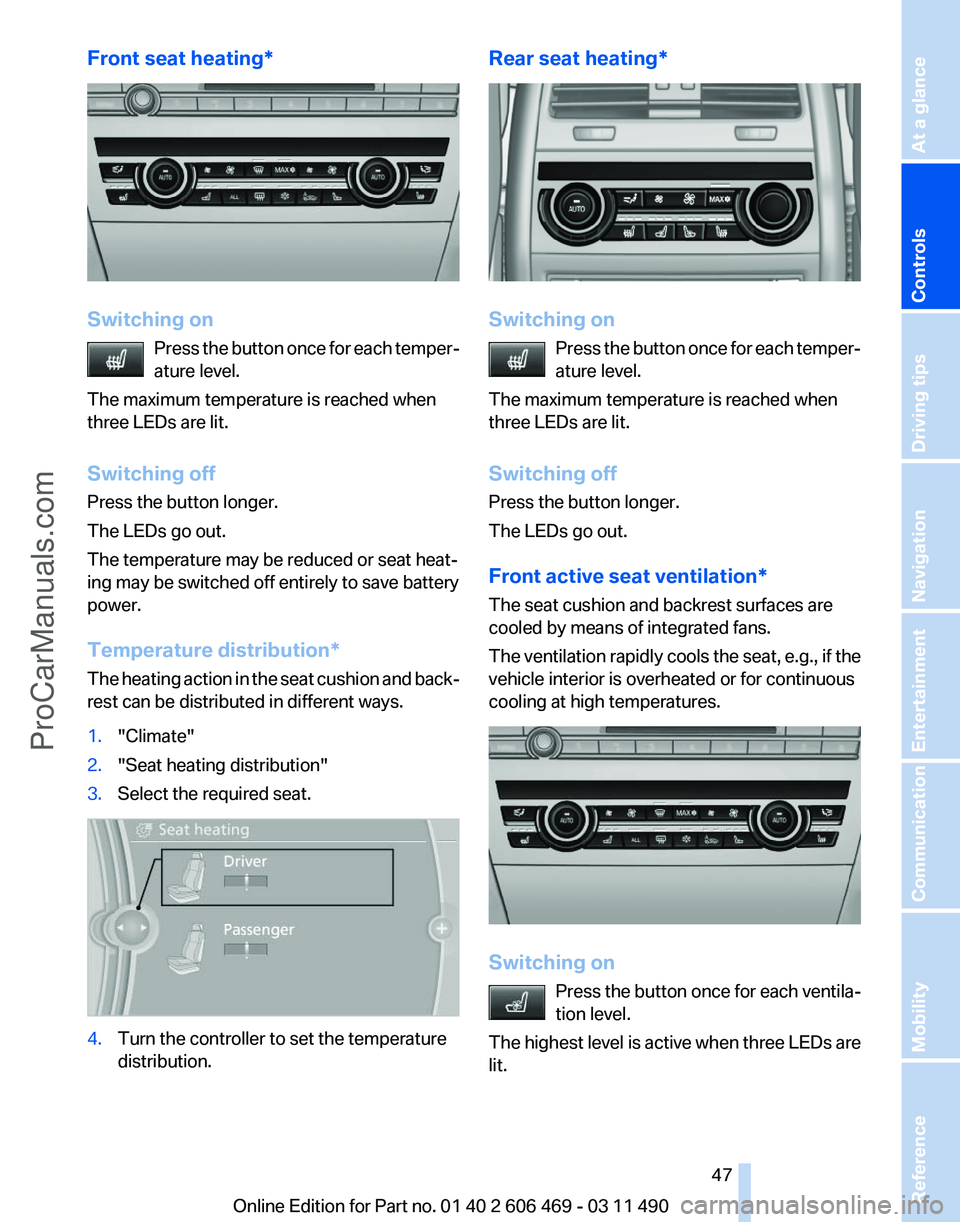
Front seat heating*
Switching on
Press the button once for each temper‚Äê
ature level.
The maximum temperature is reached when
three LEDs are lit.
Switching off
Press the button longer.
The LEDs go out.
The temperature may be reduced or seat heat‚Äê
ing may be switched off entirely to save battery
power.
Temperature distribution*
The heating action in the seat cushion and back‚Äê
rest can be distributed in different ways.
1. "Climate"
2. "Seat heating distribution"
3. Select the required seat. 4.
Turn the controller to set the temperature
distribution. Rear seat heating*
Switching on
Press the button once for each temper‚Äê
ature level.
The maximum temperature is reached when
three LEDs are lit.
Switching off
Press the button longer.
The LEDs go out.
Front active seat ventilation*
The seat cushion and backrest surfaces are
cooled by means of integrated fans.
The ventilation rapidly cools the seat, e.g., if the
vehicle interior is overheated or for continuous
cooling at high temperatures. Switching on
Press
the button once for each ventila‚Äê
tion level.
The highest level is active when three LEDs are
lit. Seite 47
47Online Edition for Part no. 01 40 2 606 469 - 03 11 490
Reference Mobility Communication Entertainment Navigation Driving tips
Controls At a glance
ProCarManuals.com
Page 52 of 304
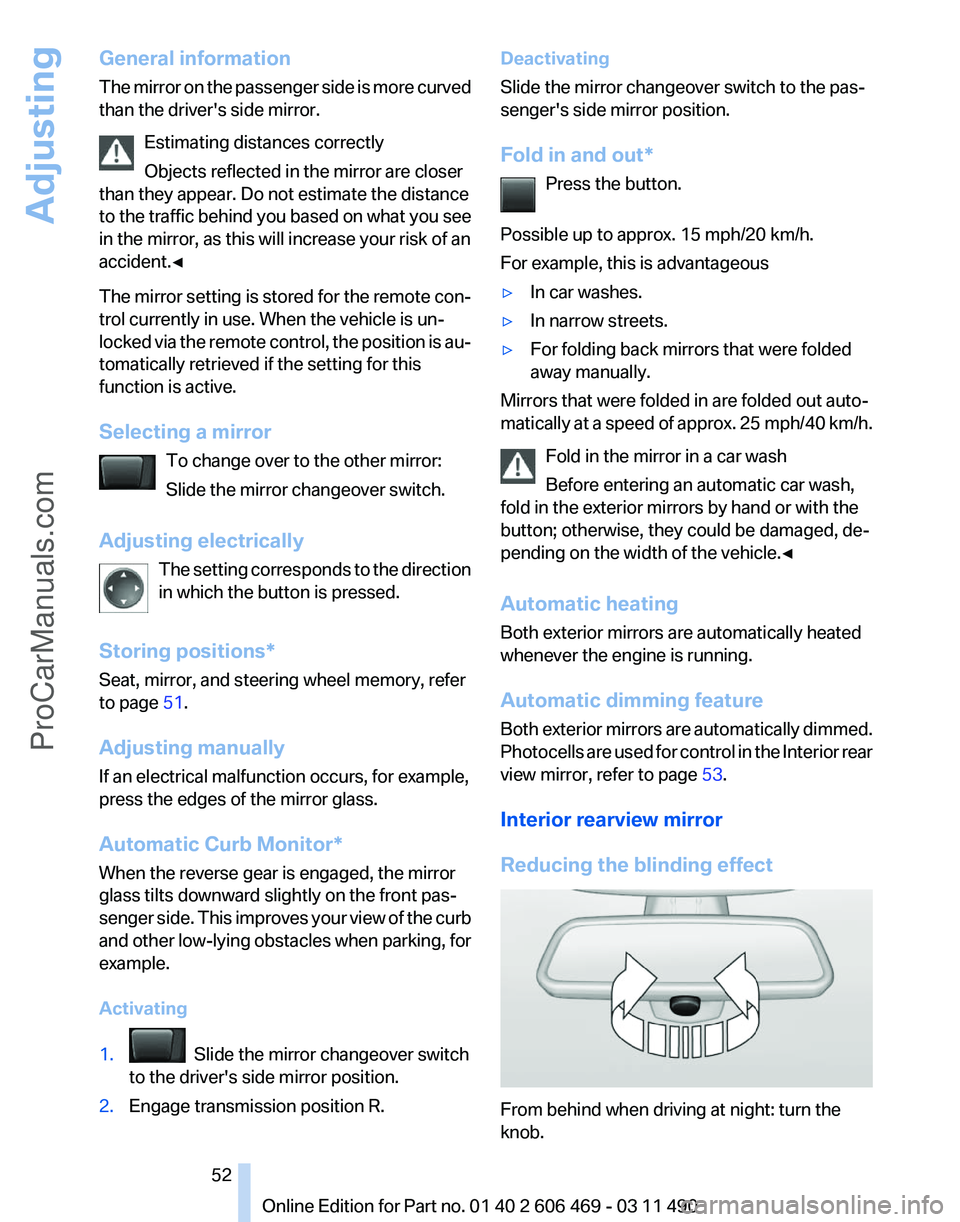
General information
The
mirror on the passenger side is more curved
than the driver's side mirror.
Estimating distances correctly
Objects reflected in the mirror are closer
than they appear. Do not estimate the distance
to the traffic behind you based on what you see
in the mirror, as this will increase your risk of an
accident.‚óÄ
The mirror setting is stored for the remote con‚Äê
trol currently in use. When the vehicle is un‚Äê
locked via the remote control, the position is au‚Äê
tomatically retrieved if the setting for this
function is active.
Selecting a mirror
To change over to the other mirror:
Slide the mirror changeover switch.
Adjusting electrically The setting corresponds to the direction
in which the button is pressed.
Storing positions*
Seat, mirror, and steering wheel memory, refer
to page 51.
Adjusting manually
If an electrical malfunction occurs, for example,
press the edges of the mirror glass.
Automatic Curb Monitor*
When the reverse gear is engaged, the mirror
glass tilts downward slightly on the front pas‚Äê
senger side. This improves your view of the curb
and other low-lying obstacles when parking, for
example.
Activating
1. Slide the mirror changeover switch
to the driver's side mirror position.
2. Engage transmission position R. Deactivating
Slide the mirror changeover switch to the pas‚Äê
senger's side mirror position.
Fold in and out*
Press the button.
Possible up to approx. 15 mph/20 km/h.
For example, this is advantageous
‚ñ∑ In car washes.
‚ñ∑ In narrow streets.
‚ñ∑ For folding back mirrors that were folded
away manually.
Mirrors that were folded in are folded out auto‚Äê
matically
at a speed of approx. 25 mph/40 km/h.
Fold in the mirror in a car wash
Before entering an automatic car wash,
fold in the exterior mirrors by hand or with the
button; otherwise, they could be damaged, de‚Äê
pending on the width of the vehicle.‚óÄ
Automatic heating
Both exterior mirrors are automatically heated
whenever the engine is running.
Automatic dimming feature
Both exterior mirrors are automatically dimmed.
Photocells are used for control in the Interior rear
view mirror, refer to page 53.
Interior rearview mirror
Reducing the blinding effect From behind when driving at night: turn the
knob. Seite 52
52 Online Edition for Part no. 01 40 2 606 469 - 03 11 490
Adjusting
ProCarManuals.com
Page 53 of 304
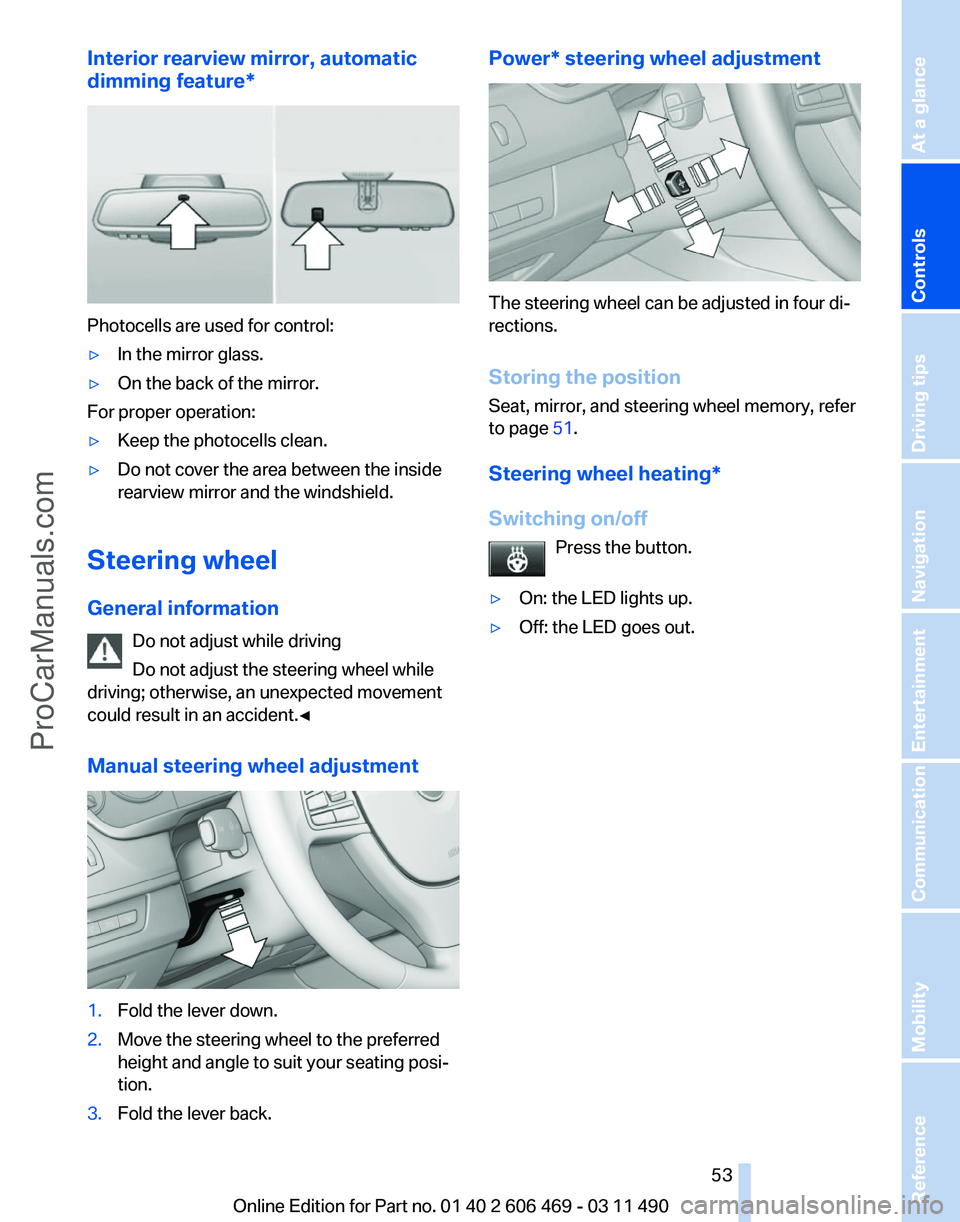
Interior rearview mirror, automatic
dimming feature
*Photocells are used for control:
‚ñ∑
In the mirror glass.
‚ñ∑ On the back of the mirror.
For proper operation:
‚ñ∑ Keep the photocells clean.
‚ñ∑ Do not cover the area between the inside
rearview mirror and the windshield.
Steering wheel
General information Do not adjust while driving
Do not adjust the steering wheel while
driving; otherwise, an unexpected movement
could result in an accident.‚óÄ
Manual steering wheel adjustment 1.
Fold the lever down.
2. Move the steering wheel to the preferred
height and angle to suit your seating posi‚Äê
tion.
3. Fold the lever back. Power* steering wheel adjustment
The steering wheel can be adjusted in four di‚Äê
rections.
Storing the position
Seat, mirror, and steering wheel memory, refer
to page
51.
Steering wheel heating
*
Switching on/off Press the button.
‚ñ∑ On: the LED lights up.
‚ñ∑ Off: the LED goes out. Seite 53
53Online Edition for Part no. 01 40 2 606 469 - 03 11 490
Reference Mobility Communication Entertainment Navigation Driving tips
Controls At a glance
ProCarManuals.com
Page 59 of 304
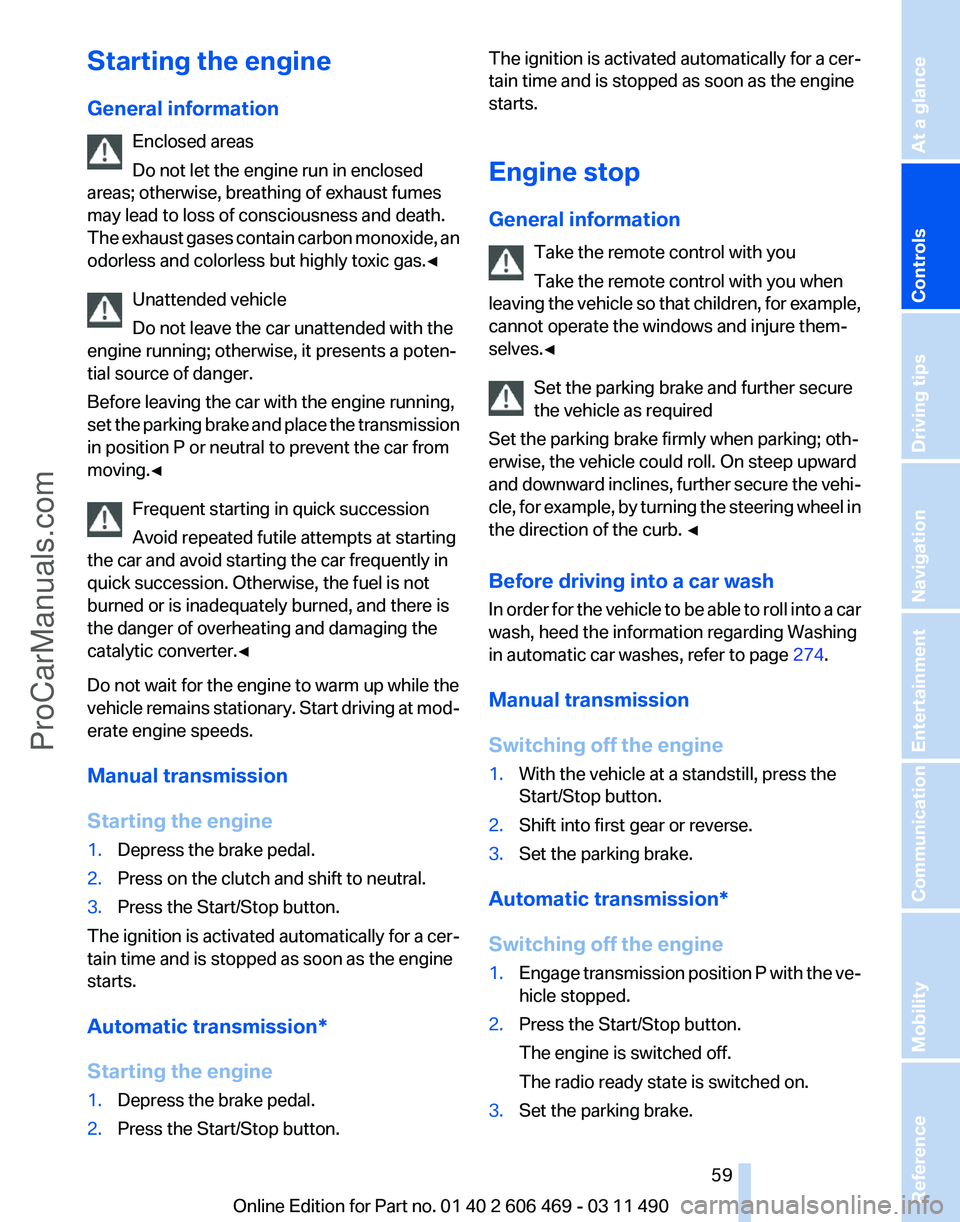
Starting the engine
General information
Enclosed areas
Do not let the engine run in enclosed
areas; otherwise, breathing of exhaust fumes
may lead to loss of consciousness and death.
The
exhaust gases contain carbon monoxide, an
odorless and colorless but highly toxic gas.‚óÄ
Unattended vehicle
Do not leave the car unattended with the
engine running; otherwise, it presents a poten‚Äê
tial source of danger.
Before leaving the car with the engine running,
set the parking brake and place the transmission
in position P or neutral to prevent the car from
moving.‚óÄ
Frequent starting in quick succession
Avoid repeated futile attempts at starting
the car and avoid starting the car frequently in
quick succession. Otherwise, the fuel is not
burned or is inadequately burned, and there is
the danger of overheating and damaging the
catalytic converter.‚óÄ
Do not wait for the engine to warm up while the
vehicle remains stationary. Start driving at mod‚Äê
erate engine speeds.
Manual transmission
Starting the engine
1. Depress the brake pedal.
2. Press on the clutch and shift to neutral.
3. Press the Start/Stop button.
The ignition is activated automatically for a cer‚Äê
tain time and is stopped as soon as the engine
starts.
Automatic transmission
*
Starting the engine
1. Depress the brake pedal.
2. Press the Start/Stop button. The ignition is activated automatically for a cer‚Äê
tain time and is stopped as soon as the engine
starts.
Engine stop
General information
Take the remote control with you
Take the remote control with you when
leaving
the vehicle so that children, for example,
cannot operate the windows and injure them‚Äê
selves.‚óÄ
Set the parking brake and further secure
the vehicle as required
Set the parking brake firmly when parking; oth‚Äê
erwise, the vehicle could roll. On steep upward
and downward inclines, further secure the vehi‚Äê
cle, for example, by turning the steering wheel in
the direction of the curb. ‚óÄ
Before driving into a car wash
In order for the vehicle to be able to roll into a car
wash, heed the information regarding Washing
in automatic car washes, refer to page 274.
Manual transmission
Switching off the engine
1. With the vehicle at a standstill, press the
Start/Stop button.
2. Shift into first gear or reverse.
3. Set the parking brake.
Automatic transmission*
Switching off the engine
1. Engage transmission position P with the ve‚Äê
hicle stopped.
2. Press the Start/Stop button.
The engine is switched off.
The radio ready state is switched on.
3. Set the parking brake. Seite 59
59Online Edition for Part no. 01 40 2 606 469 - 03 11 490
Reference Mobility Communication Entertainment Navigation Driving tips
Controls At a glance
ProCarManuals.com
Page 126 of 304
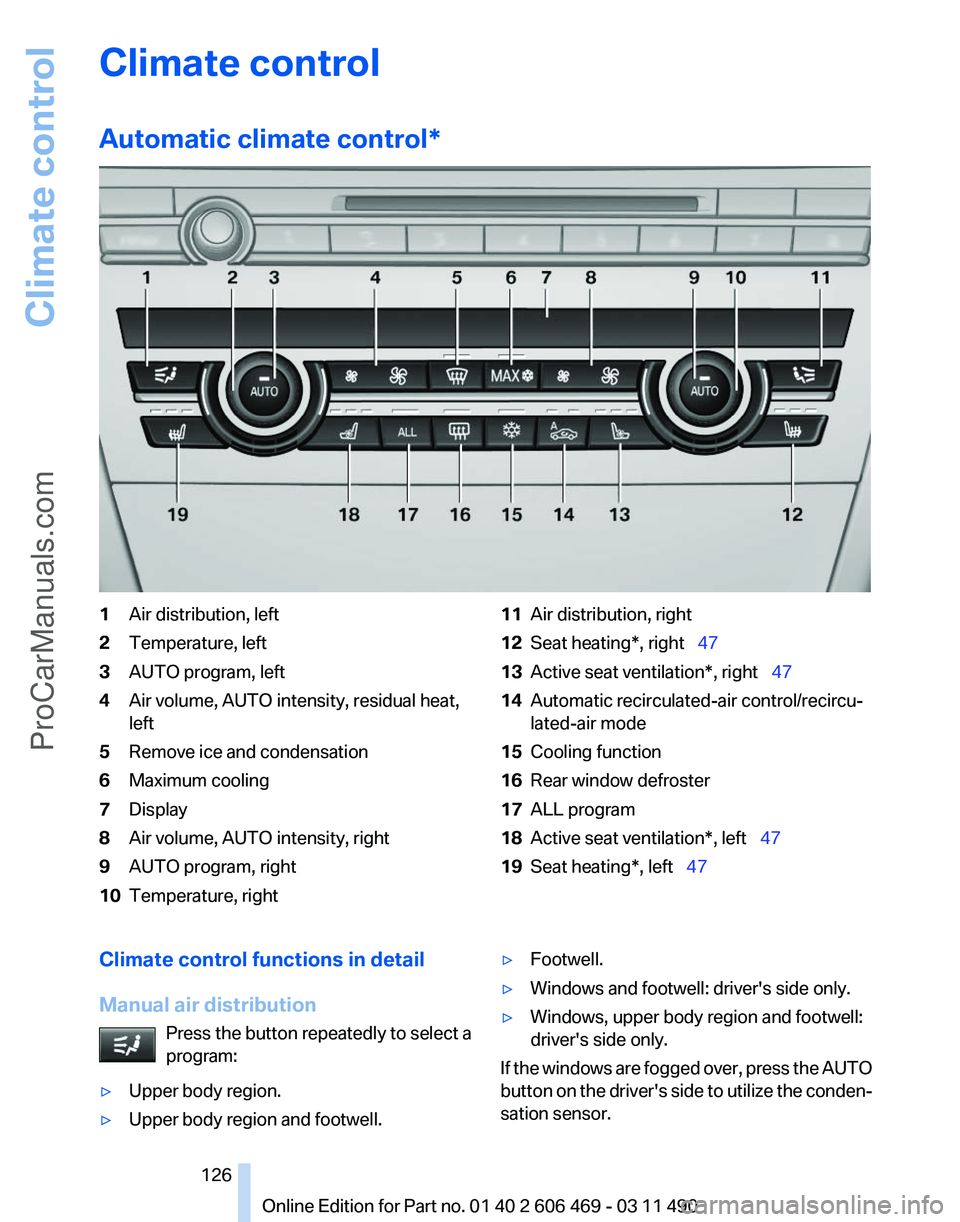
Climate control
Automatic climate control
*1
Air distribution, left
2 Temperature, left
3 AUTO program, left
4 Air volume, AUTO intensity, residual heat,
left
5 Remove ice and condensation
6 Maximum cooling
7 Display
8 Air volume, AUTO intensity, right
9 AUTO program, right
10 Temperature, right 11
Air distribution, right
12 Seat heating*, right‚ÄÇ‚ÄÖ 47
13 Active seat ventilation*, right‚ÄÇ‚ÄÖ47
14 Automatic recirculated-air control/recircu‚Äê
lated-air mode
15 Cooling function
16 Rear window defroster
17 ALL program
18 Active seat ventilation*, left‚ÄÇ‚ÄÖ47
19 Seat heating*, left‚ÄÇ‚ÄÖ 47
Climate control functions in detail
Manual air distribution Press the button repeatedly to select a
program:
‚ñ∑ Upper body region.
‚ñ∑ Upper body region and footwell. ‚ñ∑
Footwell.
‚ñ∑ Windows and footwell: driver's side only.
‚ñ∑ Windows, upper body region and footwell:
driver's side only.
If the windows are fogged over, press the AUTO
button
on the driver's side to utilize the conden‚Äê
sation sensor.
Seite 126
126 Online Edition for Part no. 01 40 2 606 469 - 03 11 490
Climate control
ProCarManuals.com
Page 127 of 304
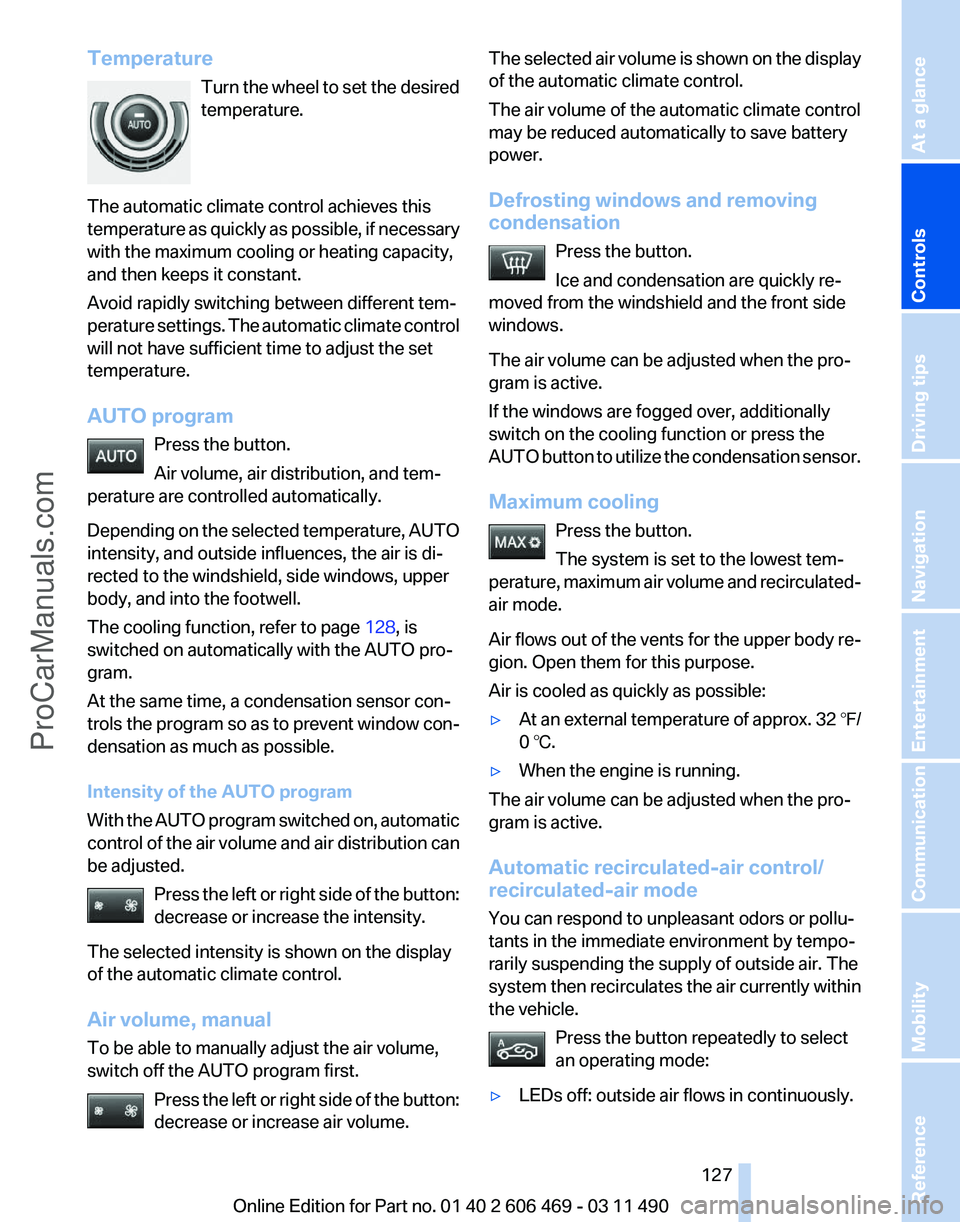
Temperature
Turn the wheel to set the desired
temperature.
The automatic climate control achieves this
temperature as quickly as possible, if necessary
with the maximum cooling or heating capacity,
and then keeps it constant.
Avoid rapidly switching between different tem‚Äê
perature settings. The automatic climate control
will not have sufficient time to adjust the set
temperature.
AUTO program Press the button.
Air volume, air distribution, and tem‚Äê
perature are controlled automatically.
Depending on the selected temperature, AUTO
intensity, and outside influences, the air is di‚Äê
rected to the windshield, side windows, upper
body, and into the footwell.
The cooling function, refer to page 128, is
switched on automatically with the AUTO pro‚Äê
gram.
At the same time, a condensation sensor con‚Äê
trols the program so as to prevent window con‚Äê
densation as much as possible.
Intensity of the AUTO program
With the AUTO program switched on, automatic
control of the air volume and air distribution can
be adjusted.
Press the left or right side of the button:
decrease or increase the intensity.
The selected intensity is shown on the display
of the automatic climate control.
Air volume, manual
To be able to manually adjust the air volume,
switch off the AUTO program first. Press the left or right side of the button:
decrease or increase air volume. The selected air volume is shown on the display
of the automatic climate control.
The air volume of the automatic climate control
may be reduced automatically to save battery
power.
Defrosting windows and removing
condensation
Press the button.
Ice and condensation are quickly re‚Äê
moved from the windshield and the front side
windows.
The air volume can be adjusted when the pro‚Äê
gram is active.
If the windows are fogged over, additionally
switch on the cooling function or press the
AUTO
button to utilize the condensation sensor.
Maximum cooling Press the button.
The system is set to the lowest tem‚Äê
perature, maximum air volume and recirculated-
air mode.
Air flows out of the vents for the upper body re‚Äê
gion. Open them for this purpose.
Air is cooled as quickly as possible:
‚ñ∑ At an external temperature of approx. 32 ‚Ñâ/
0 ‚ÑÉ.
‚ñ∑ When the engine is running.
The air volume can be adjusted when the pro‚Äê
gram is active.
Automatic recirculated-air control/
recirculated-air mode
You can respond to unpleasant odors or pollu‚Äê
tants in the immediate environment by tempo‚Äê
rarily suspending the supply of outside air. The
system
then recirculates the air currently within
the vehicle.
Press the button repeatedly to select
an operating mode:
‚ñ∑ LEDs off: outside air flows in continuously. Seite 127
127Online Edition for Part no. 01 40 2 606 469 - 03 11 490
Reference Mobility Communication Entertainment Navigation Driving tips
Controls At a glance
ProCarManuals.com
Page 130 of 304
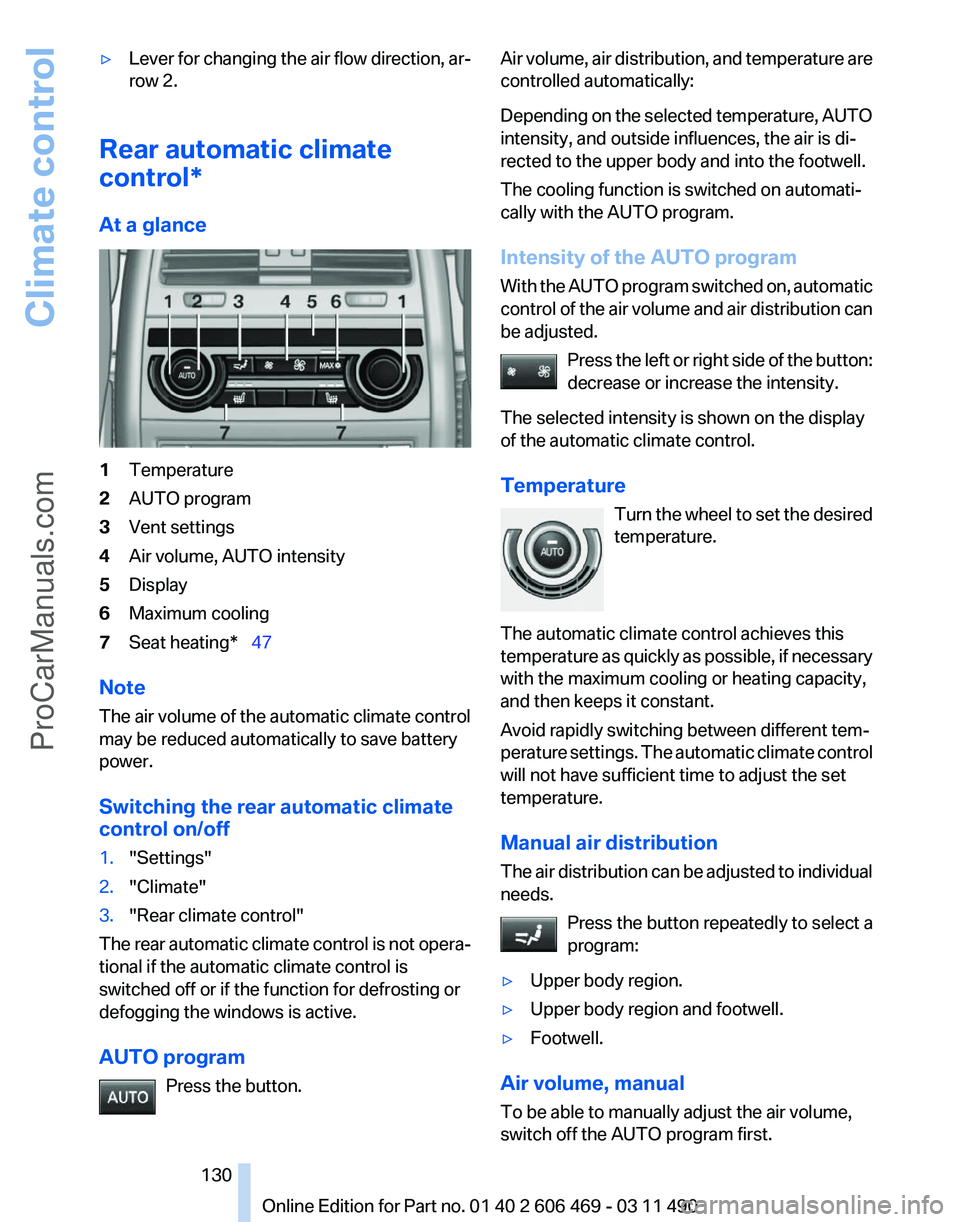
‚ñ∑
Lever for changing the air flow direction, ar‚Äê
row 2.
Rear automatic climate
control*
At a glance 1
Temperature
2 AUTO program
3 Vent settings
4 Air volume, AUTO intensity
5 Display
6 Maximum cooling
7 Seat heating*‚ÄÇ‚ÄÖ47
Note
The air volume of the automatic climate control
may be reduced automatically to save battery
power.
Switching the rear automatic climate
control on/off
1. "Settings"
2. "Climate"
3. "Rear climate control"
The rear automatic climate control is not opera‚Äê
tional if the automatic climate control is
switched off or if the function for defrosting or
defogging the windows is active.
AUTO program Press the button. Air volume, air distribution, and temperature are
controlled automatically:
Depending
on the selected temperature, AUTO
intensity, and outside influences, the air is di‚Äê
rected to the upper body and into the footwell.
The cooling function is switched on automati‚Äê
cally with the AUTO program.
Intensity of the AUTO program
With the AUTO program switched on, automatic
control of the air volume and air distribution can
be adjusted.
Press the left or right side of the button:
decrease or increase the intensity.
The selected intensity is shown on the display
of the automatic climate control.
Temperature Turn the wheel to set the desired
temperature.
The automatic climate control achieves this
temperature as quickly as possible, if necessary
with the maximum cooling or heating capacity,
and then keeps it constant.
Avoid rapidly switching between different tem‚Äê
perature settings. The automatic climate control
will not have sufficient time to adjust the set
temperature.
Manual air distribution
The air distribution can be adjusted to individual
needs. Press the button repeatedly to select a
program:
‚ñ∑ Upper body region.
‚ñ∑ Upper body region and footwell.
‚ñ∑ Footwell.
Air volume, manual
To be able to manually adjust the air volume,
switch off the AUTO program first. Seite 130
130 Online Edition for Part no. 01 40 2 606 469 - 03 11 490
Climate control
ProCarManuals.com
Page 148 of 304
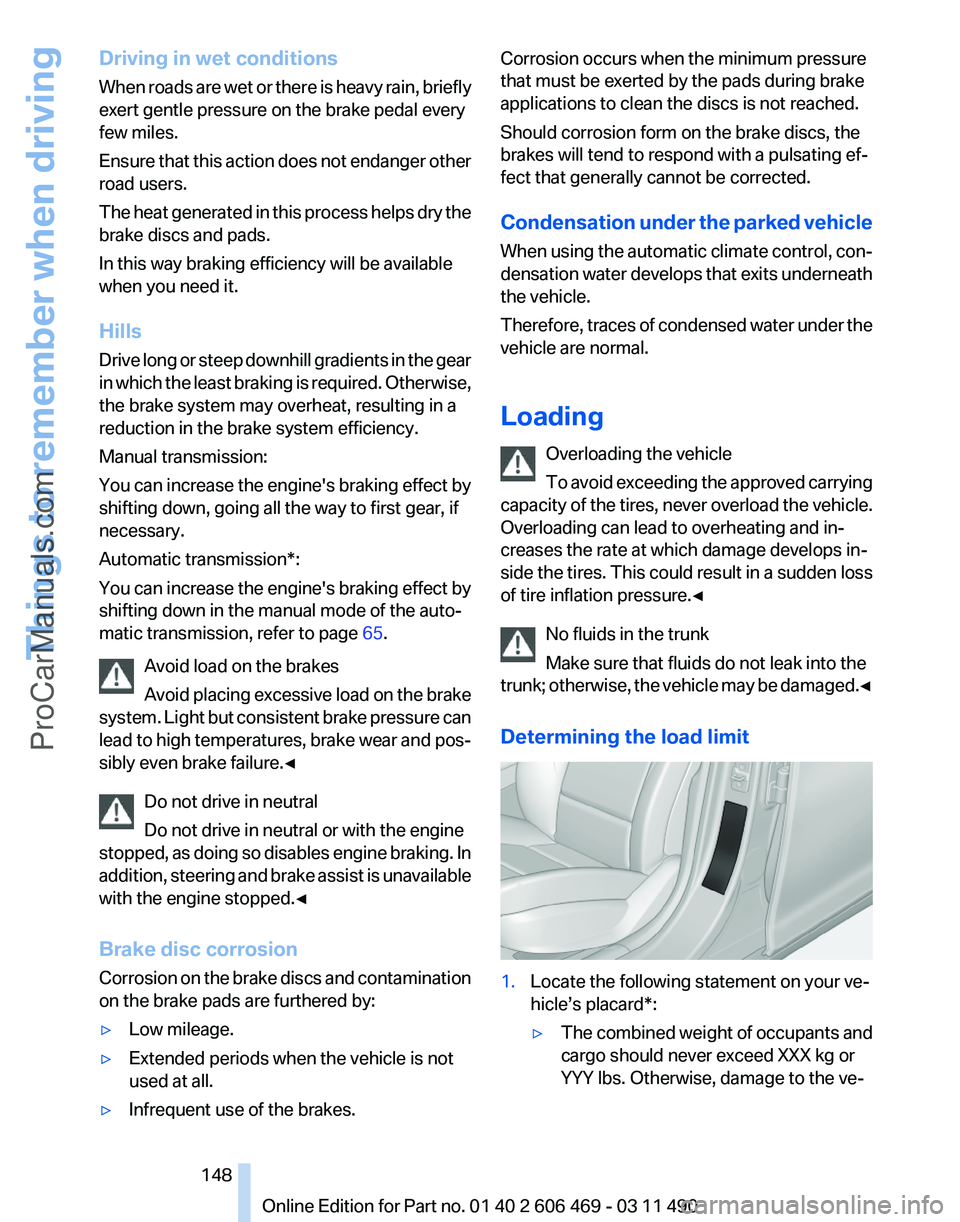
Driving in wet conditions
When
roads are wet or there is heavy rain, briefly
exert gentle pressure on the brake pedal every
few miles.
Ensure that this action does not endanger other
road users.
The heat generated in this process helps dry the
brake discs and pads.
In this way braking efficiency will be available
when you need it.
Hills
Drive long or steep downhill gradients in the gear
in which the least braking is required. Otherwise,
the brake system may overheat, resulting in a
reduction in the brake system efficiency.
Manual transmission:
You can increase the engine's braking effect by
shifting down, going all the way to first gear, if
necessary.
Automatic transmission*:
You can increase the engine's braking effect by
shifting down in the manual mode of the auto‚Äê
matic transmission, refer to page 65.
Avoid load on the brakes
Avoid placing excessive load on the brake
system. Light but consistent brake pressure can
lead to high temperatures, brake wear and pos‚Äê
sibly even brake failure.‚óÄ
Do not drive in neutral
Do not drive in neutral or with the engine
stopped, as doing so disables engine braking. In
addition, steering and brake assist is unavailable
with the engine stopped.‚óÄ
Brake disc corrosion
Corrosion on the brake discs and contamination
on the brake pads are furthered by:
‚ñ∑ Low mileage.
‚ñ∑ Extended periods when the vehicle is not
used at all.
‚ñ∑ Infrequent use of the brakes. Corrosion occurs when the minimum pressure
that must be exerted by the pads during brake
applications to clean the discs is not reached.
Should corrosion form on the brake discs, the
brakes will tend to respond with a pulsating ef‚Äê
fect that generally cannot be corrected.
Condensation
under the parked vehicle
When using the automatic climate control, con‚Äê
densation water develops that exits underneath
the vehicle.
Therefore, traces of condensed water under the
vehicle are normal.
Loading
Overloading the vehicle
To avoid exceeding the approved carrying
capacity of the tires, never overload the vehicle.
Overloading can lead to overheating and in‚Äê
creases the rate at which damage develops in‚Äê
side the tires. This could result in a sudden loss
of tire inflation pressure.‚óÄ
No fluids in the trunk
Make sure that fluids do not leak into the
trunk; otherwise, the vehicle may be damaged.‚óÄ
Determining the load limit 1.
Locate the following statement on your ve‚Äê
hicle’s placard*:
‚ñ∑The combined weight of occupants and
cargo should never exceed XXX kg or
YYY lbs. Otherwise, damage to the ve‚Äê Seite 148
148 Online Edition for Part no. 01 40 2 606 469 - 03 11 490
Things to remember when driving
ProCarManuals.com
Page 151 of 304
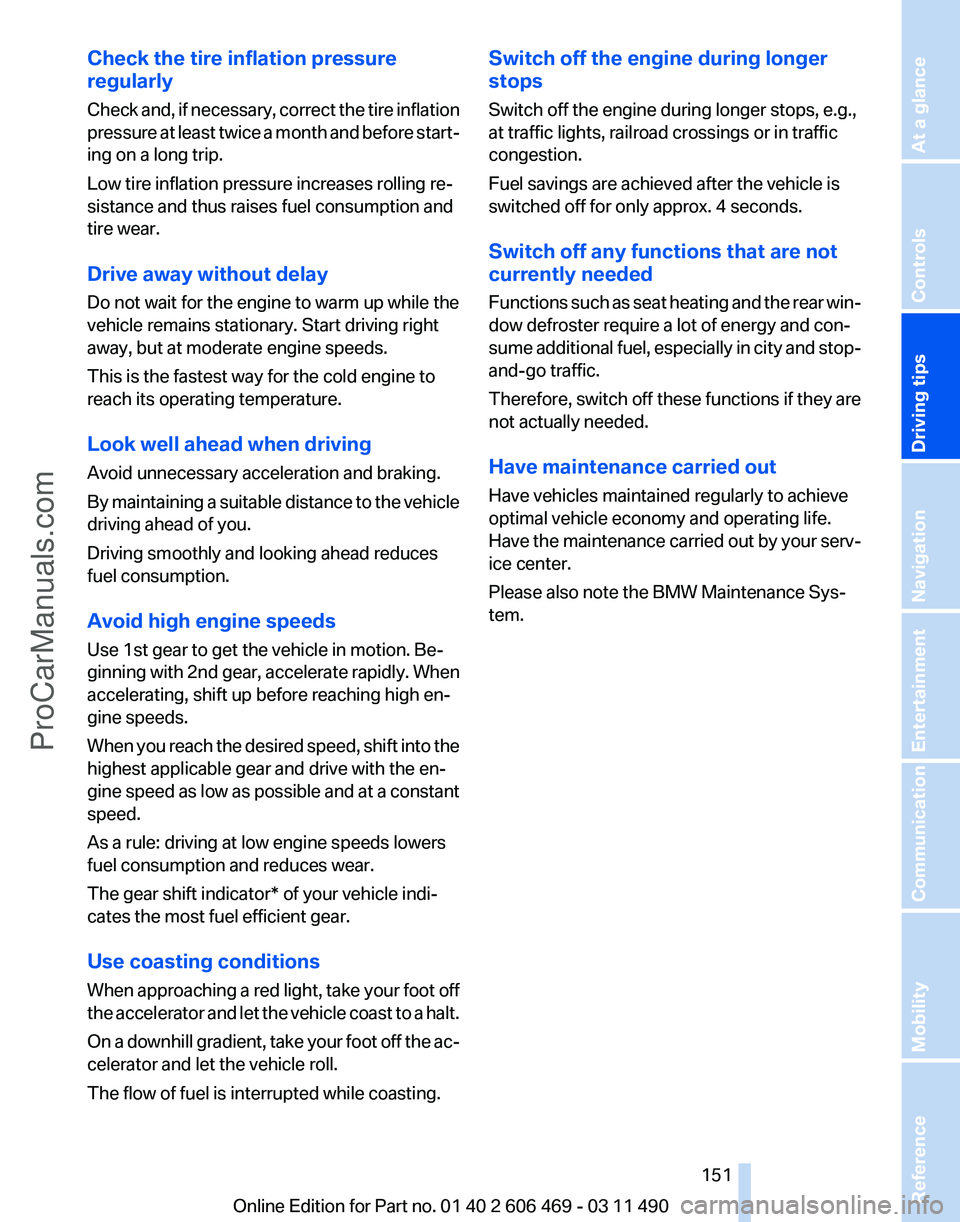
Check the tire inflation pressure
regularly
Check
and, if necessary, correct the tire inflation
pressure at least twice a month and before start‚Äê
ing on a long trip.
Low tire inflation pressure increases rolling re‚Äê
sistance and thus raises fuel consumption and
tire wear.
Drive away without delay
Do not wait for the engine to warm up while the
vehicle remains stationary. Start driving right
away, but at moderate engine speeds.
This is the fastest way for the cold engine to
reach its operating temperature.
Look well ahead when driving
Avoid unnecessary acceleration and braking.
By maintaining a suitable distance to the vehicle
driving ahead of you.
Driving smoothly and looking ahead reduces
fuel consumption.
Avoid high engine speeds
Use 1st gear to get the vehicle in motion. Be‚Äê
ginning with 2nd gear, accelerate rapidly. When
accelerating, shift up before reaching high en‚Äê
gine speeds.
When you reach the desired speed, shift into the
highest applicable gear and drive with the en‚Äê
gine speed as low as possible and at a constant
speed.
As a rule: driving at low engine speeds lowers
fuel consumption and reduces wear.
The gear shift indicator* of your vehicle indi‚Äê
cates the most fuel efficient gear.
Use coasting conditions
When approaching a red light, take your foot off
the accelerator and let the vehicle coast to a halt.
On a downhill gradient, take your foot off the ac‚Äê
celerator and let the vehicle roll.
The flow of fuel is interrupted while coasting. Switch off the engine during longer
stops
Switch off the engine during longer stops, e.g.,
at traffic lights, railroad crossings or in traffic
congestion.
Fuel savings are achieved after the vehicle is
switched off for only approx. 4 seconds.
Switch off any functions that are not
currently needed
Functions
such as seat heating and the rear win‚Äê
dow defroster require a lot of energy and con‚Äê
sume additional fuel, especially in city and stop-
and-go traffic.
Therefore, switch off these functions if they are
not actually needed.
Have maintenance carried out
Have vehicles maintained regularly to achieve
optimal vehicle economy and operating life.
Have the maintenance carried out by your serv‚Äê
ice center.
Please also note the BMW Maintenance Sys‚Äê
tem.
Seite 151
151Online Edition for Part no. 01 40 2 606 469 - 03 11 490
Reference Mobility Communication Entertainment Navigation
Driving tips Controls At a glance
ProCarManuals.com